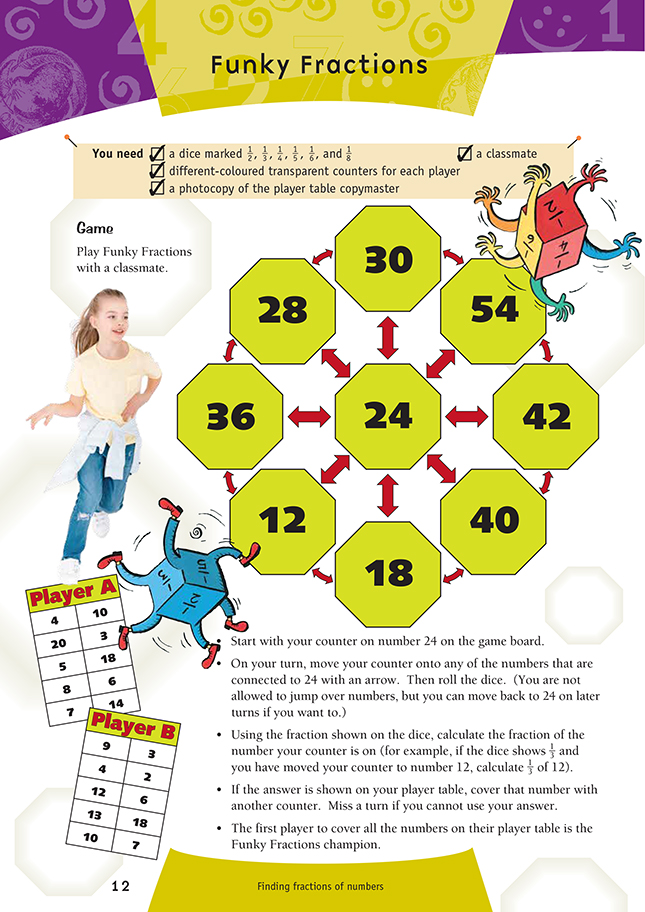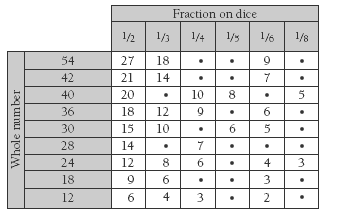This is a level 3 number activity from the Figure It Out series. It relates to Stage 6 of the Number Framework.
A PDF of the student activity is included.
Click on the image to enlarge it. Click again to close. Download PDF (243 KB)
find a fraction of a number
Different coloured transparent counters for each player
A dice marked 1/2. 1/3, 1/4, 1/5, and 1/6
FIO, Level 3-4, Number, Book 2, Funky Fractions, page 12
Player table Copymaster
A classmate
Game
This game is self-explanatory and relies on students having a strong knowledge of multiplication facts and the ability to apply them to division and find fractions of numbers. Only single-unit fractions are used, so the students only need to divide the whole number by the denominator. For example, 1/3 of 12 is 12 ÷ 3 = 4.
Early additive students will use additive part–whole mental strategies when calculating fractions of whole numbers. For example, 1/4 is half of a half, and 1/8 is half of a quarter, so to find 1/4 of 24, “half of 24 is 12, and half of 12 is 6, so 1/4 of 24 is 6”; to find 1/8 of 40, “half of 40 is 20, half of 20 is 10, and half of 10 is 5, so 1/8 of 40 is 5”.
Students who are advanced additive or beyond will be able to solve the fractions of whole numbers using known multiplication and division facts, for example, 1/5 x 30 is 30 ÷ 5 = 6.
Funky Fractions is a game of tactics because not all the whole numbers on the game board are equally divisible by the denominators shown on the dice. All 9 numbers are divisible by 2, there are 7 numbers divisible by either 3 or 6, 5 numbers divisible by 4, 2 numbers divisible by 5, and 2 by 8.
An interesting challenge for the students would be to calculate the comparative fairness of the two player tables, assuming that all dice throws are equally fair. To do this, they would need to calculate all the possible outcomes of their throws.
The students could then summarise this information about the factors and the dice throw outcomes and compare it to the player tables for positive outcomes. There are 32 possible positive outcomes. There is a 3/32 chance of getting a 9, a 2/32 or 1/16 chance of getting a 4, and so on.
In terms of probability, player B is slightly more likely to win than player A, given the combination of whole numbers on the tables. This is unlikely to be an issue when the students are playing the game, but it would be an interesting exercise for the students to record the winning table for each game to determine whether some player tables are more likely to win than others, given the statistical probability of the outcomes. This would require a minimum of 30 tests. The students could then design tables of their own.
You could extend students who quickly master the game by asking them to design their own game board and player tables. This could lead them to investigate which numbers can be divided by 2, 3, 4, 5, 6, and 8 and could be linked with objectives in probability, identifying possible outcomes and assigning numerical probabilities for covering a particular number on the player’s table in order to design a “fair” table.
Alternatively, the game could be played again, giving more emphasis to the fractions by using a dice that showed mixed fractions instead of unit fractions, for example, 2/3. (2/3 of 24 is 24 ÷ 3 x 2 = 16.)
Answers to Activity
Game
A game for finding fractions of numbers


